Chapter A
The output of educational institutions and the impact of learning
Archived Content
Information identified as archived is provided for reference, research or recordkeeping purposes. It is not subject to the Government of Canada Web Standards and has not been altered or updated since it was archived. Please "contact us" to request a format other than those available.
Skip to text
- A1 Educational attainment of the adult population
- A2 Upper secondary graduation
- A3 Labour market outcomes
Text begins
A1 Educational attainment of the adult population
Context
This indicator provides a profile of the educational attainment of the adult population aged 25 to 64; that is, the percentage of that population that has successfully completed a certain level of education. For this international indicator, educational attainment reflects the highest level of education completed, based on the International Standard Classification of Education (ISCED) categories.Note 1 As all subsequent indicators are examined by educational attainment within this international structure, this opening indicator, A1, sets the stage with an overview of the situation in Canada, including a breakdown of attainment by sex to reveal any gender differences. Overall trends are also presented, and information on generational differences reflects the shifts in educational attainment over time. This portrait of educational attainment places Canada and its provinces and territories in an international context.
Education helps give individuals the tools they need to participate in social and economic life and is key to the social and economic well-being of a country. As a large number of people in the 25-to-64 age range will have completed their formal education, this indicator provides some information on the skills and knowledge of this segment of the population, the core one active in the labour market. Overall, the educational attainment of all individuals in the working-age population influences the competitiveness of economies and the prosperity of societies. Variations in attainment over time reflect differences in access to education, and indicate the evolution of knowledge available.
The distribution of educational attainment across Canada should not be considered an exact reflection of any educational system’s output because many other factors come into play; for example, differences in labour market and economic situations, in the relative magnitude of international and inter-jurisdictional migrations, and the overall mobility of students and workers.
Observations
Educational attainment in Canada
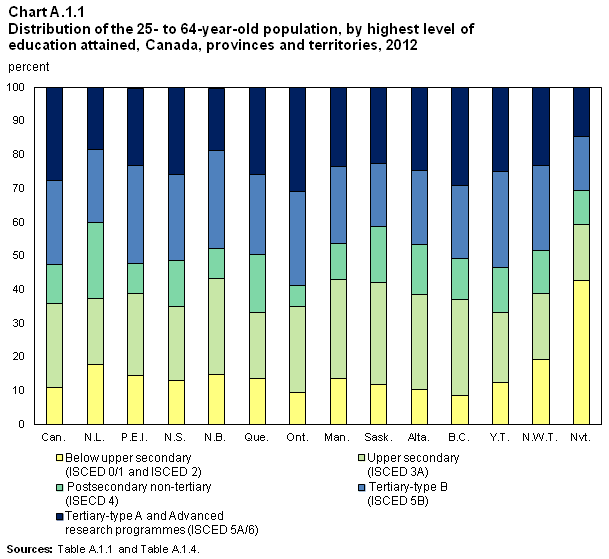
- Over half of Canadians aged 25 to 64 had completed a college or university education.
- One-quarter (25%) of Canadians had attained a college qualification (ISCED 5B), while 28% had completed their education at the university level (ISCED 5A/6). Approximately 12% attained a “postsecondary non-tertiary education” (ISCED 4), which includes certificates or diplomas from vocational schools or apprenticeship training.Note 2
- Roughly 1 in 10 Canadians (11%) had not completed high school (“upper secondary”; ISCED 3A).
Gender differences, Canada and OECD
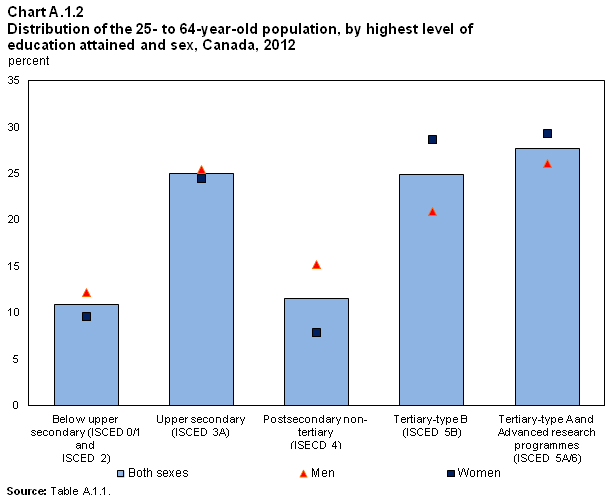
- Men and women had similar levels of attainment until the end of high school (upper secondary ISCED 3). Larger gender differences emerge for postsecondary attainment.
- At ISCED level 4, which captures the traditionally male-dominated areas of trades, the proportion of men (15%) was close to double that of women (8%). The opposite was true at the college (ISCED 5B) and university (ISCED 5A/6) levels, with the gap more marked at college (29% for women vs 21% for men) than university (29% for women and 26% for men).
Tertiary attainment
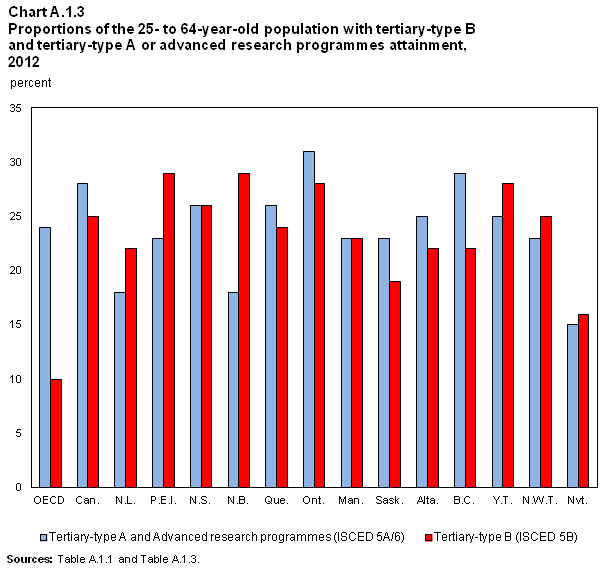
- Among OECD countries, 10% of 25- to 64-year-olds, on average, had completed college (tertiary-type B) programs in 2012, far fewer than the 25% reported for Canada. This number reflects Canada’s well-developed college sector.
- The corresponding international figure for university (tertiary-type A/advanced research programmes) was 24%, much closer to Canada’s 28% average.
- Within Canada, university attainment ranged from 15% in Nunavut to 31% in Ontario. For college, the numbers range from 16% in Nunavut to 29% in Prince Edward Island and New Brunswick. Both educational sectors are strong in all jurisdictions.
Generational differences in tertiary attainment
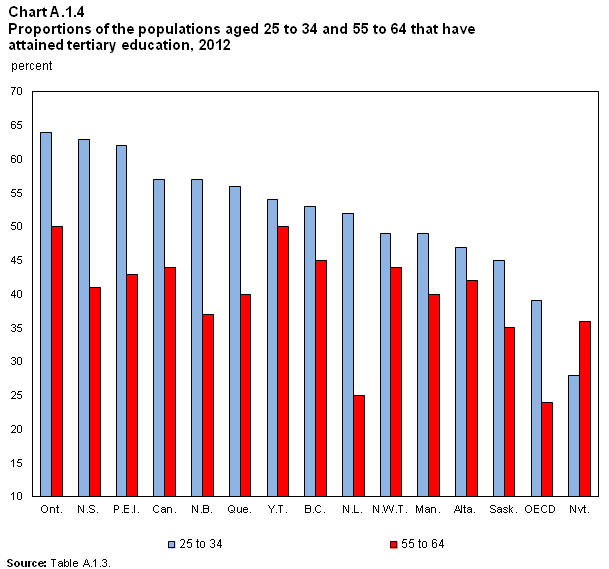
- Younger people have a higher level of educational attainment than their older counterparts in Canada and other OECD countries.
- Canada’s level of tertiary attainment among the older and younger generations is higher than the OECD average. This is also true in virtually all of the provinces and territories.
- A different pattern is seen in Nunavut, where the proportion of adults with a tertiary credential is higher among the older age group.
Trends in attainment levels
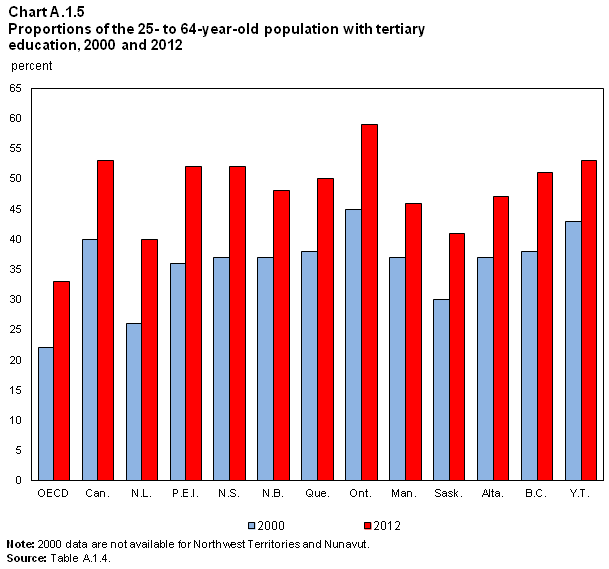
- Between 2000 and 2012, the proportion of the Canadian population attaining tertiary education increased by close to one-third (from 40% to 53%).
Definitions, sources and methodology
This indicator examines educational attainment among Canada’s adult population aged 25 to 64, by age group and sex. It presents a portrait of the situation in 2012, but also shows the evolution since 2000.
The percentage of the population represented by a given age group that has attained a particular education level is obtained by taking the number of persons in this age group who have received a diploma attesting to that level, dividing it by the total number of persons in this same age group, and then multiplying by 100.
The education level corresponds to the highest level of education an individual has attained. The designation of the different levels of schooling is based on the International Standard Classification of Education (ISCED-97) (see the “ISCED classifications and descriptions” and the “Mapping to ISCED” section for the Labour Force Survey [LFS] in Notes to readers). An individual must have successfully completed a programme at a given ISCED level to be considered as having attained that level of education. An individual who has not successfully completed a programme is assigned the preceding education level. For example, a secondary school graduate, as well as an individual who has undertaken some postsecondary education but who has not obtained a credential at that level, is considered to have attained ISCED level 3; a student who has not successfully completed secondary school, ISCED level 2.
The 2012 information presented for Canada on population and educational attainment is based on data from the LFS, which surveys approximately 56,000 households every month.Note 3 The LFS seeks to obtain a detailed and timely picture of the population aged 15 or older throughout the country. It allows proxy reporting, meaning that information on the entire household can be collected from a single member of the household. In all, this type of reporting accounts for approximately 65% of all information collected. Figures from the Organisation for Economic Co-operation and Development (OECD) are those reported by the OECD, and are drawn from OECD and Eurostat databases, as compiled from national labour force surveys or population registers.
Some limitations are encountered when using LFS data to examine and categorize educational attainment using ISCED as it is not possible to make a precise delineation between “postsecondary non-tertiary education” and “tertiary-type B education programmes”. LFS data reported for the Canadian population that has attained ISCED level 5B will be somewhat overestimated because this category includes, for example, some CEGEP or college university transfer program graduates who, under the international classification standards, would have been placed in ISCED level 4.
In Statistics Canada’s LFS, advanced research qualifications (doctorates), educational attainment at ISCED 6, cannot be identified separately; therefore, educational attainment in the ISCED 5A and 6 categories must be counted together.
Note: The corresponding OECD indicator is A1, To what level have adults studied?.
Tables for A1 Educational attainment of the adult population
A2 Upper secondary graduation
Context
This indicator presents upper secondary school graduation rates. Graduation rates are often seen as a measure of student achievement. A comparison of overall rates gives some information about the extent to which school systems are succeeding in providing students with what is universally recognized as an important educational milestone. Presenting rates by sex reveals whether any gender differences exist; this in turn can signal whether those systems are meeting the needs of both male and female students. The share of graduates under 25 years of age among all graduates is also presented.
Upper secondary graduation is the foundation for further education. It has become an essential milestone for most students and provides economic and social benefits for society. Historically, males had been much more likely to graduate from secondary school; however, that pattern has been reversed for many years in Canada and almost all other OECD member countries. Whether male or female, the value of graduating from high school also extends beyond the academic qualification by giving individuals what is now widely considered the minimum requirement for entry into the labour market.
Another dimension presented by this indicator is the successful completion of upper secondary programmes based on a synthetic cohort for public schools. To a certain extent, this indicator reveals the effectiveness of Canada’s various public education systems in producing graduates within the three-year period typically considered by the OECD as the normal duration of an upper secondary education program (on-time graduation). In Canada, this period would be equivalent to Grades 10 to 12, or, in Quebec, Grades 9 to 11.
Observations
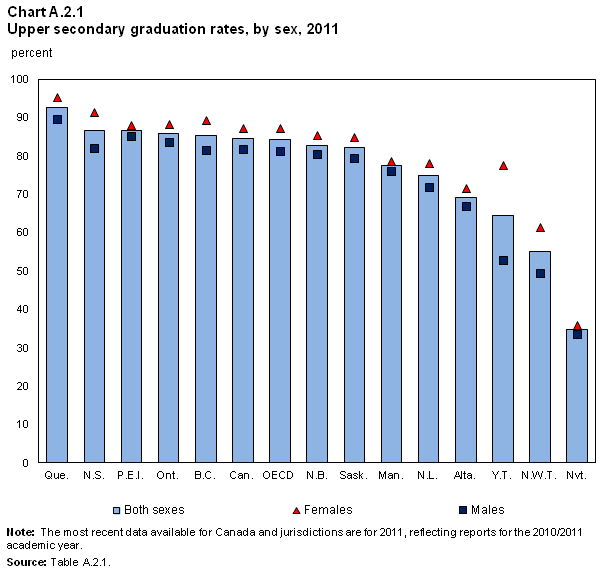
Upper secondary graduation rates
- Canada’s high school (“upper secondary”) graduation rate was 85% in 2011.Note 4 The majority of other OECD member countries also reported graduation rates of at least 80%, and the latest OECD average (2011) was 84%.
Graduation rates higher for females
- In Canada in 2011, the graduation rate for females was higher (87%) than that for males (82%), similar to the OECD female and male averages.
Successful completion of upper secondary programmes
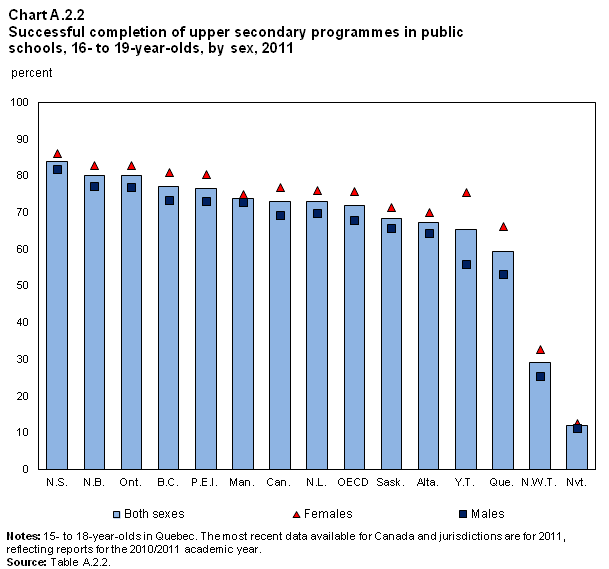
- Close to three quarters of students (73%) complete high school within the three-year period typically covered by upper secondary education. The average “on-time” graduation rate for OECD countries was 72%.Note 5
- The proportion of students who completed their education in the expected time varied considerably across the country: from 12% in Nunavut to 84% in Nova Scotia.
- The successful on-time completion of upper secondary programmes was higher for females than for their male counterparts in all provinces and territories. For the provinces, the lowest female-male gap was in Manitoba at 2 percentage points while the highest was in Quebec (13). At the Canada level the difference was 8 percentage points.
Definitions, sources and methodology
This indicator presents net upper secondary graduation rates without duplication (i.e., first-time graduates) by sex. It also presents successful completion of upper secondary programmes of a proxy cohort in public schools.
Upper secondary graduation rates
These rates are an estimation of the probability that an individual will graduate from high school during his or her lifetime, assuming that current conditions related to graduation all remain the same.Note 6
Upper secondary graduation rates are the sum of graduation rates by age, and the latter are obtained by dividing graduates of a specific age by the population of the corresponding specific age. Rates without duplication only count individuals who had obtained, during a given year, a diploma at this level for the first time.Note 7 In general, a graduate of upper secondary education is considered to have successfully completed the last year of education at this level, regardless of his or her age.
All data for Canada reflect the 2010/2011 school year; the OECD averages reflect 2011/2012. Information for Canada was drawn from the Elementary-Secondary Education Survey (ESES), an administrative survey that collects data for public and private educational institutions from the provincial and territorial ministries/departments of education.Note 8 To ensure comparability with other OECD countries, Statistics Canada added, for all provinces and territories (except Ontario and Nova Scotia, for which data were estimated), the number of 2010/2011 graduates from private schools provided by provinces and territories at ESES collection. The number of graduates from First Nations band-operated schools (these data were obtained from Aboriginal Affairs and Northern Development Canada), were also added to the number of public and private school graduates and included in the calculation of the upper secondary graduation rates presented.
Population estimates used in the denominator of the graduation rate calculation cover the entire population, including Aboriginal people, as of January 1, 2011.
Successful completion of upper secondary programmes in public schools
An adjusted proxy cohort for examination of the successful completion of upper secondary programmes has been developed for public schools (as per the scope of the ESES data collection) for Canada and the jurisdictions. It was calculated by dividing the number of 16- to 19-year-old graduates (15- to 18-year-olds in Quebec) in 2010/2011 by the number of Grade 10 (3e secondaire in Quebec) enrolments recorded three years earlier (i.e., in 2008/2009). This ratio has been adjusted to take into account deaths and interprovincial and international migration factors.
The adjustment factor is generated by dividing the 14- to 15-year-old population in 2008 (which represents the Grade 10 students) by the 17- to 18-year-old population in 2011 (which represents the Grade 10 students who graduated three years later). For Canada, where there is more in-migration than out-migration, the adjustment factor is below 100%. If this adjustment is not made, the inclusion of recent in-migrants who were not part of the original Grade 10 cohort would result in an overestimation of the number of graduates that were part of the original universe (the 2008 Grade 10 enrolments). This adjustment implicitly assumes that graduation rates of recent immigrants are identical to graduation rates of those in the original cohort.
Other possible flows in and out of the public school system between enrolment in Grade 10 and graduation at the end of Grade 12 may exist; for example, movement between public and private schools. Such possibilities could not be taken into consideration, however, as the appropriate data that would be needed to estimate such flows are not available at this time.
International data collection
The international figures used by the OECD are obtained from the UOE collection of statistical data on education, carried out jointly by three international organizations (UNESCO, the OECD, and Eurostat), and conducted in 2013 by the OECD.
Note: The corresponding OECD indicator is A2, How many students are expected to complete upper secondary education?.
Tables for A2 Upper secondary graduation
A3 Labour market outcomes
Context
This indicator examines the connection between educational attainment and the labour market by looking at employment rates among the adult population aged 25 to 64. This relationship is explored by sex, and information by age group is provided. Trends in employment rates by educational attainment are also presented. Educational attainment reflects the highest level of education successfully completed, based on the International Standard Classification of Education (ISCED) categories.Note 9
One of the main objectives of education systems is to prepare individuals so they can participate in a knowledge-oriented economy and society. From an educational perspective, it is interesting to examine the impact of educational attainment on employability. In OECD countries, upper secondary (high school) graduation is considered the minimum requirement for finding a good job and being competitive in the labour market. Moreover, employability, judged on the basis of the employment rate (the ratio of the number of persons with a job in a given group to the total population of that group), increases with the amount of education attained.
Although employment rates reflect a complex combination of economic, institutional and social factors that vary from country to country, or from one province/territory to another, job prospects and employment rates are generally better for those individuals with higher education.
In general, differences across the country largely relate to the structure and composition of individual provincial economies. The employment rates in all four western provinces indicate provincial economies that drive relatively high employment rates regardless of educational attainment.
Observations
Employment rates by attainment
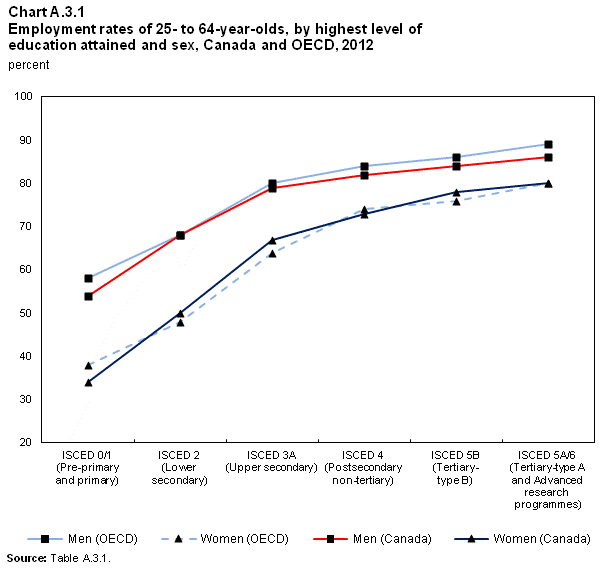
- Employment rates rose with levels of educational attainment both in Canada and at the OECD average.
- In Canada and for the OECD average, women had consistently lower employment rates than men.
- This gender gap in employment rates was largest (around 20 percentage points) among those with the least education and smallest (6 percentage points) among the men and women with a college or university credential (ISCED 5B and 5A/6).
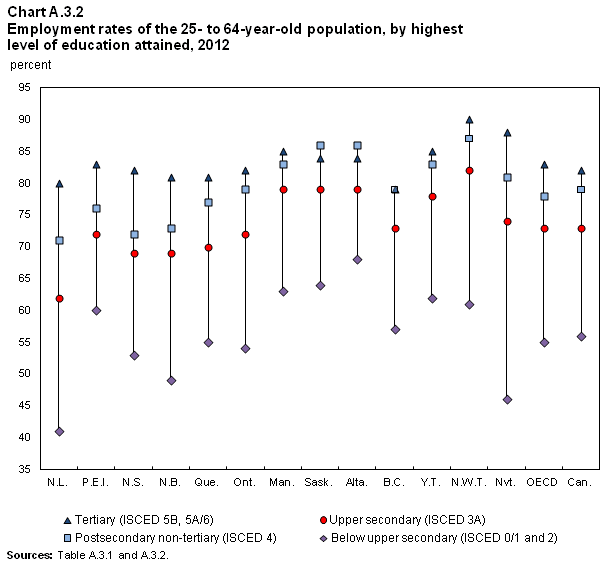
- Employment rates also rose with levels of educational attainment across all provinces and territories. However, the magnitude and the nature of the educational advantage varied among the jurisdictions.
- In general, the size of the differences in employment rates associated with educational attainment were less pronounced in the west compared with the east.
- Although tertiary graduates generally had the highest employment rates in 2012, this was not true in Saskatchewan and Alberta, where those with ISCED 4 attainment (trade certificates, vocational diplomas, or apprenticeship training)Note 10 had the highest employment rates.
Definitions, sources and methodology
This indicator, labour market outcomes, examines the relationship between educational attainment and the employment rates of 25- to 64-year-olds, overall, by sex, and by age group. It also provides insight into how this relationship has evolved over time.
The employment rate represents the percentage of employed people in this population. To calculate the employment rate for a group with a particular level of educational attainment, the number of employed persons with the particular level of educational attainment is divided by the total number of persons in the population aged 25 to 64 who have attained that education level and then multiplying this quotient by 100.
The concepts and definitions of “employment” and “unemployment” adopted by the Labour Force Survey (LFS) are based on those endorsed by the International Labour Organisation (ILO). Employed persons are those who, during the reference week: (1) did any work at all at a job or business, that is, paid work in the context of an employer-employee relationship, or self-employment. It also includes unpaid family work, which is defined as unpaid work contributing directly to the operation of a farm, business or professional practice owned and operated by a related member of the same household; or (2) had a job but were not at work due to factors such as own illness or disability, personal or family responsibilities, vacation, labour dispute or other reasons (excluding persons on layoff, between casual jobs, and those with a job to start at a future date). The education level is measured according to the highest level of schooling completed.
The 2012 data for Canada and its provinces and territories were drawn from the Labour Force Survey (LFS), which surveys approximately 56,000 households every month.Note 11 The LFS excludes the following from the scope of the survey: individuals who live on reserves or in other Aboriginal settlements in the provinces, full-time members of the Canadian Forces and institutional residents. The LFS employment rate is based on a monthly average from January to December. Figures from the Organisation for Economic Co-operation and Development (OECD) are those reported by the OECD, and they are extracted from the OECD and Eurostat databases compiled from national labour force surveys for the OECD member countries.
Note: The corresponding OECD indicator is A5, How does educational attainment affect participation in the labour market?.
Tables for A.3 Labour market outcomes
Notes
- Date modified:
